by Heather Kent | Jul 5, 2022
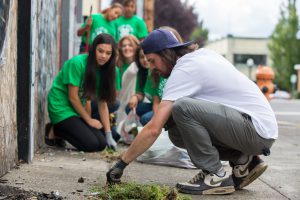 In a recent study, one of the top things 4-H volunteers are looking for are ideas for adapting activities to different age groups (Kent, 2022). Florida 4-H offers experiences for four different age groups: Cloverbuds (ages 5-7), Juniors (ages 8-10), Intermediates (ages 11-13), and Seniors (ages 14-18). One of the great things about 4-H is that the whole family can participate! This also means that 4-H volunteers often find themselves working with a variety of age groups. That might seem a little overwhelming, but this post series gives practical tips and strategies to make it less daunting. This week’s post is focused on adapting activities for intermediate-age 4-H members. In case you missed it, check out the previous couple of weeks’ posts to learn about cloverbuds, juniors, and intermediates.
In a recent study, one of the top things 4-H volunteers are looking for are ideas for adapting activities to different age groups (Kent, 2022). Florida 4-H offers experiences for four different age groups: Cloverbuds (ages 5-7), Juniors (ages 8-10), Intermediates (ages 11-13), and Seniors (ages 14-18). One of the great things about 4-H is that the whole family can participate! This also means that 4-H volunteers often find themselves working with a variety of age groups. That might seem a little overwhelming, but this post series gives practical tips and strategies to make it less daunting. This week’s post is focused on adapting activities for intermediate-age 4-H members. In case you missed it, check out the previous couple of weeks’ posts to learn about cloverbuds, juniors, and intermediates.
What are “Ages & Stages” and Why Does it Matter?
“Ages & stages” is a phrase commonly used in youth development that refers to the physical, social, emotional, and cognitive development of a young person. These categories of development are based on the work of researchers such as Piaget and Erickson. Understanding these categories help 4-H volunteers and professionals provide opportunities for youth to thrive through social and emotional learning and is a key part of the 4-H Thrive Model (Arnold & Gagnon, 2020). There are several benefits of selecting (or adapting) age-appropriate activities for youth:
- First, it makes learning fun! Fun is important; boring is bad.
- Youth are more engaged. When activities are not too challenging or too easy, they are in what’s called the “zone of proximal development,” or ZPD (Vygotsky, 1978). This is key to helping learners master new skills. ZPD refers to skills or knowledge that are too difficult for a youth to master on their own, but possible to master with guidance from a more knowledgeable person- like their 4-H volunteer!
- Youth can build on past learning experiences and create future opportunities to grow.
- When learning is fun and youth are engaged, youth stay involved in 4-H!
How to Use “Ages & Stages” to help Seniors Thrive
Social Development of 14-18 year-olds (how they act)
Youth who are 14-18 years old continue to establish a strong sense of self. They enjoy opportunities to work together as a team and develop strong friendships. They are also developing social networks and beginning to think more seriously about their future. 4-H is a great way for youth in this age group to prepare for life beyond high school by fine-tuning interview and communication skills and building a network of friends and adults that have the same interests as theirs.
| Typical social behaviors for 14-18-year olds include: |
Strategies for supporting the social development of
14-18 -year olds |
- Developing their self-identity – what makes them unique
- Continues to want more freedom from parental control and the power to make some of their own decisions
- Still likes to participate as a member of a group but is now aware of and exploring the different roles, especially that of a mentor or teacher for younger youth.
- Seeks peer group acceptance like before, plus now, status matters
- Understands the benefits of sharing and working together.
|
- Provide opportunities to share, learn and explore people’s different values, abilities, uniqueness, etc. so they can begin to identify their own
- Continue to give youth the opportunity to plan, implement and evaluate 4-H activities.
- Encourage youth to take on leadership roles and mentor younger youth
- Foster a sense of belonging in which youth are accepted, encouraged, and supported by their peers.
- Provide opportunities for youth to create groups and decide which groups they want to be in
- Build-in or plan for opportunities where youth can recognize each other’s accomplishments
|
Cognitive Development of 14-18-year-olds (how they think)
Youth that are 14-18 -years old can think logically and apply abstract reasoning, so problem-solving and critical thinking are a way to help youth in this age group learn. One of the best ways for youth in this age group to demonstrate mastery is by teaching younger youth. Many of our project areas have opportunities for older youth to serve in a “teens as teachers” role. Another way to engage older youth is in district and state leadership positions. Florida 4-H offers several opportunities for teens to plan district and statewide events through District Council and State Executive Board. Youth in this age group will also be interested in using their problem-solving and critical thinking skills to compete at the National levels in their project area.
| Typical learning behaviors for 14-18 -year olds include: |
Strategies for Supporting Cognitive Development
of 14-18-year olds: |
- Enjoys exploring ideas and these can be abstract or virtual
- Learns best when new ideas are linked to their interests
- Able to multi-task
- Able to mentor and teach younger youth
- Able to plan a whole event- especially at the District or State level
- Can apply critical thinking and problem-solving skills to National Contest opportunities.
|
- Engage teens in District and National activities, teams, projects, etc.
- Encourage teens to demonstrate mastery in their project work by teaching or mentoring younger youth with similar interests.
- Empower teens to lead and plan a wide range of activities, encouraging them to be creative and put their own “twist”
|
Throughout this series, we have been using examples from each of the three pillar programs in 4-H: Citizenship & Leadership, Science, and Healthy Living. These examples are meant to help parents and volunteers see how an activity can be adapted for each of the different age groups. For examples for other age groups, check out our previous posts about Cloverbuds, Juniors, and Intermediates.
- Citizenship & Leadership: For citizenship & leadership, we have been using the example of a 4-H club business meeting. Fourteen to 18 year olds are going to be more interested in learning about leadership roles beyond the club and county level- encourage them to run for a district or state office, or serve on a statewide planning committee for a 4-H event. Youth in this age group might also be interested in participating in the 4-H Citizenship Washington Focus to learn more about leadership and government at the national level.
- Science: For science, we have been using the 4-H entomology project as an example. Entomology is the study of insects. Youth that are 14-18 can help lead the entomology project at the county level and compete 4-H Insectathon contest to earn a college scholarship. Encourage youth to participate in a 4-H University track to learn more about careers in Entomology. Youth may also want to participate in the National 4-H Agriscience Summit.
- Healthy Living: For Healthy Living, we have been using the 4-H personal wellness project as an example. This project area helps youth learn about nutrition, physical fitness, and mental health. For seniors, they can teach a workshop on personal wellness at 4-H Teen Retreat, or apply for Community Pride funds to address a problem related to personal wellness. 4-H seniors would also be interested in attending the National 4-H Healthy Living Summit.
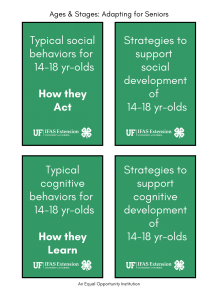 Using the “Ages & Stages” approach with youth reinforces the Essential Elements of 4-H: Belonging, Mastery, Independence, and Generosity. This is also key to helping youth thrive. However, each individual youth grows at their own pace and might not completely meet the general tendencies listed above. As volunteers and 4-H professionals, it is important to observe youth and meet them where they are physically sociality, and intellectually. Adapting activities on the fly gets easier with practice- download this set of flashcards for a quick reference guide. You can print them, cut them out, and punch them to fit on a lanyard as a handy teaching aid. Your local 4-H agent is always available to help and provide additional resources if you have questions.
Using the “Ages & Stages” approach with youth reinforces the Essential Elements of 4-H: Belonging, Mastery, Independence, and Generosity. This is also key to helping youth thrive. However, each individual youth grows at their own pace and might not completely meet the general tendencies listed above. As volunteers and 4-H professionals, it is important to observe youth and meet them where they are physically sociality, and intellectually. Adapting activities on the fly gets easier with practice- download this set of flashcards for a quick reference guide. You can print them, cut them out, and punch them to fit on a lanyard as a handy teaching aid. Your local 4-H agent is always available to help and provide additional resources if you have questions.
References:
- Arnold, M. E. & Gagnon, R. J. (2020). Positive youth development theory in practice: An update on the 4-H Thriving Model. Journal of Youth Development, 15(6), 1-23.
- Erikson, E. H. (1963). Childhood and Society (2nd Ed.). New York: Norton.
- Kent, H.C. (2022). Informal learning to support volunteer performance. [Unpublished doctoral dissertation]. Florida State University.
- Lee, F. and Go, C. (2002). Developmental stages. UC ANR 4-H Youth Development Program.
- Piaget, J. (1971). The theory of stages in cognitive development. In D. R. Green, M. P. Ford, & G. B. Flamer, Measurement and Piaget. McGraw-Hill.
- Pleskac, S. (2000). Educational design and delivery: Use of age-appropriate activities. VRKC fact sheet.
- Vygotsky, L. S. (1978). Mind in society: The development of higher psychological processes. Cambridge, MA: Harvard University Press.
by Heather Kent | Jul 4, 2022
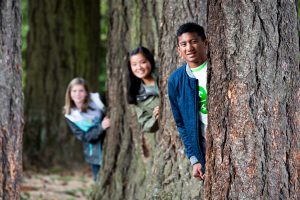 In a recent study, one of the top things 4-H volunteers are looking for are ideas for adapting activities to different age groups (Kent, 2022). Florida 4-H offers experiences for four different age groups: Cloverbuds (ages 5-7), Juniors (ages 8-10), Intermediates (ages 11-13) and Seniors (ages 14-18). One of the great things about 4-H is that the whole family can participate! This also means that 4-H volunteers often find themselves working with a variety of age groups. That might seem a little overwhelming, but this post series gives practical tips and strategies to make it less daunting. This week’s post is focused on adapting activities for intermediate-age 4-H members. In case you missed it, check out the previous couple of weeks posts to learn about cloverbuds and juniors.
In a recent study, one of the top things 4-H volunteers are looking for are ideas for adapting activities to different age groups (Kent, 2022). Florida 4-H offers experiences for four different age groups: Cloverbuds (ages 5-7), Juniors (ages 8-10), Intermediates (ages 11-13) and Seniors (ages 14-18). One of the great things about 4-H is that the whole family can participate! This also means that 4-H volunteers often find themselves working with a variety of age groups. That might seem a little overwhelming, but this post series gives practical tips and strategies to make it less daunting. This week’s post is focused on adapting activities for intermediate-age 4-H members. In case you missed it, check out the previous couple of weeks posts to learn about cloverbuds and juniors.
What are “Ages & Stages” and Why Does it Matter?
“Ages & stages” is a phrase commonly used in youth development that refers to the physical, social, emotional, and cognitive development of a young person. These categories of development are based on the work of researchers such as Piaget and Erickson. Understanding these categories help 4-H volunteers and professionals provide opportunities for youth to thrive through social and emotional learning and are a key part of the 4-H Thrive Model (Arnold & Gagnon, 2020). There are several benefits of selecting (or adapting) age-appropriate activities for youth:
- First, it makes learning fun! Fun is important; boring is bad.
- Youth are more engaged. When activities are not too challenging or too easy, they are in what’s called the “zone of proximal development,” or ZPD (Vygotsky, 1978). This is key to help learners master new skills. ZPD refers to skills or knowledge that are too difficult for a youth to master on their own, but possible to master with guidance from a more knowledgeable person- like their 4-H volunteer!
- Youth can build on past learning experiences and create future opportunities to grow.
- When learning is fun and youth are engaged, youth stay involved in 4-H!
How to Use “Ages & Stages” to help Intermediates Thrive
Social Development of 11-13 year-olds (how they act)
Youth who are 11-13 years old are undergoing several physical changes associated with puberty. Along with the physical changes, youth this age often struggle with personal identity. During this time, adolescents either establish their own sense of self or become confused with who they are and what they want to do in life. Helping youth discover their sparks- their own passions and interests- can help them form their self-identity.
| Typical social behaviors for 11-13-year olds include: |
Strategies for supporting social development of 11-13-year olds: |
- Developing their self-identity – what makes them unique
- Self-conscious because of puberty and the concept of self-image
- Wants more freedom from parental control and the power to make some of their own decisions
- Still likes to participate as a member of a group but now aware of and exploring the different roles (leader, participant, supporter, etc.) in a group
- Seeks peer group acceptance like before, plus now, status matters
- Understands the benefits of sharing and working together.
|
- Provide opportunities to share, learn and explore people’s different values, abilities, uniqueness, etc. so they can begin to identify their own
- Engage youth in healthy living discussions about self-image and puberty
- Extend the teamwork discussion and encourage youth to talk about different roles and the status we attach to these roles.
- Give youth the opportunity to plan, implement and evaluate 4-H activities.
- Incorporate teamwork as a component of your 4-H activities, allowing for discussion of roles, and for participants to try different roles.
- Foster a sense of belonging in which youth are accepted, encouraged, and supported by their peers.
|
Cognitive Development of 11-13-year olds (how they think)
Youth who are 11-13 years old can think logically and apply abstract reasoning. They can also manipulate mental representations. This is a great age to introduce youth to more complex ideas- particularly related to social and scientific issues that may impact their community. One way for youth in this age group to learn is through service-learning. Where they identify a problem in their neighborhood, school, or community, brainstorm solutions, select one, and implement and evaluate it.
| Typical learning behaviors for 11-13-year olds include: |
Strategies for Supporting Cognitive Development of
11-13-year olds: |
- Enjoys exploring ideas and these can be abstract or virtual
- Challenges norms, questions what is right and wrong, reasons, etc.?
- Learns best when new ideas are linked to their interests
- Able to multi-task
- Able to plan a whole event (with supervision)
|
- Engage in current events that have a right and wrong aspect, and ask them, “Thinking about this, can you come up with some reasons when someone could consider this wrong and when it could be right?”
- Engage teens in County & District Council, activities, teams, events, & projects.
- Encourage teens to identify their interests, and further explore them by allowing them to select their projects, events, etc.
- Empower teens to lead and plan a wide range of activities, encouraging them to be creative and put their own “twist”
- Engage teens in exploring what a positive body image, self-esteem, identity, etc. looks like – focus on many answers and this differs for each person
|
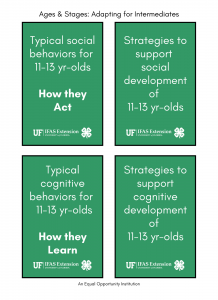 Ages & Stages Application Examples
Ages & Stages Application Examples
Throughout this series, we have been using examples from each of the three pillar programs in 4-H: Citizenship & Leadership, Science, and Healthy Living. These examples are meant to help parents and volunteers see how an activity can be adapted for each of the different age groups. For examples for other age groups, check out our previous post about Cloverbuds and our post about working with Juniors.
- Citizenship & Leadership: For citizenship & leadership, we have been using the example of a 4-H club business meeting. Eleven to 13-year-olds are going to be more interested in learning about leadership roles. Once they have some experience leading meetings at the club level, encourage them to get involved in the county and/or district leadership 4-H council. At this age, they can easily understand the proper order of a business meeting and how to make a motion. Encourage them to model this behavior to younger youth in the club. They may also be interested in leading a committee. Encourage them to be involved in planning club celebrations, fundraisers, and especially service projects.
- Science: For science, we have been using the 4-H entomology project as an example. Entomology is the study of insects. Eleven to 13-year-olds can catch, identify, and pin insects to create an insect collection. This collection could be exhibited at their county or regional fair, and can also be used as part of the 4-H Insectathon contest. Youth this age would enjoy competing in a state event like this!
- Healthy Living: For Healthy Living, we have been using the 4-H personal wellness project as an example. This project area helps youth learn about nutrition, physical fitness, and mental health. For intermediates, ask them to identify a problem at their school or community that has to do with personal wellness. Have them brainstorm solutions, select one, and plan a service project to address the need. After they implement the project, celebrate their accomplishments and help them evaluate and reflect upon their success.
Using the “Ages & Stages” approach with youth reinforces the Essential Elements of 4-H: Belonging, Mastery, Independence, and Generosity. This is also key to helping youth thrive. However, each individual youth grows at their own pace and might not completely meet the general tendencies listed above. As volunteers and 4-H professionals, it is important to observe youth and meet them where they are physically sociality, and intellectually. Adapting activities on the fly gets easier with practice- download this set of flashcards for a quick reference guide You can print them, cut them out, and punch them to fit on a lanyard as a handy teaching aid. Your local 4-H agent is always available to help and provide additional resources if you have questions.
References:
Arnold, M. E. & Gagnon, R. J. (2020). Positive youth development theory in practice: An update on the 4-H Thriving Model. Journal of Youth Development, 15(6), 1-23.
Erikson, E. H. (1963). Childhood and Society (2nd Ed.). New York: Norton.
Kent, H.C. (2022). Informal learning to support volunteer performance. [Unpublished doctoral dissertation]. Florida State University.
Lee, F. and Go, C. (2002). Developmental stages. UC ANR 4-H Youth Development Program.
Piaget, J. (1971). The theory of stages in cognitive development. In D. R. Green, M. P. Ford, & G. B. Flamer, Measurement and Piaget. McGraw-Hill.
Pleskac, S. (2000). Educational design and delivery: Use of age-appropriate activities. VRKC fact sheet.
Vygotsky, L. S. (1978). Mind in society: The development of higher psychological processes. Cambridge, MA: Harvard University Press.
by Heather Kent | Jul 3, 2022
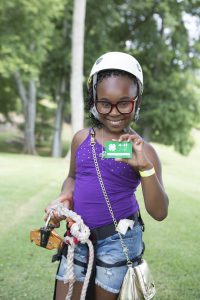 In a recent study, one of the top things 4-H volunteers are looking for are ideas for adapting activities to different age groups (Kent, 2022). Florida 4-H offers experiences for four different age groups: Cloverbuds (ages 5-7), Juniors (ages 8-10), Intermediates (ages 11-13), and Seniors (ages 14-18). 4-H encourages family involvement and engagement, and volunteers often find themselves working with a variety of age groups. That means that often, volunteers find themselves adapting activities on the fly to meet the needs of each youth. That might seem a little overwhelming, but this post series gives practical tips and strategies to make it less daunting. This week’s post is focused on adapting activities for junior age 4-H members. In case you missed it, check out last week’s post on adapting activities for Cloverbuds. This post also includes free downloadable flashcards as a handy reference tool!
In a recent study, one of the top things 4-H volunteers are looking for are ideas for adapting activities to different age groups (Kent, 2022). Florida 4-H offers experiences for four different age groups: Cloverbuds (ages 5-7), Juniors (ages 8-10), Intermediates (ages 11-13), and Seniors (ages 14-18). 4-H encourages family involvement and engagement, and volunteers often find themselves working with a variety of age groups. That means that often, volunteers find themselves adapting activities on the fly to meet the needs of each youth. That might seem a little overwhelming, but this post series gives practical tips and strategies to make it less daunting. This week’s post is focused on adapting activities for junior age 4-H members. In case you missed it, check out last week’s post on adapting activities for Cloverbuds. This post also includes free downloadable flashcards as a handy reference tool!
What are “Ages & Stages” and Why Does it Matter?
“Ages & stages” is a phrase commonly used in youth development that refers to the physical, social, emotional, and cognitive development of a young person. These categories of development are based on the work of researchers such as Piaget and Erickson. Understanding these categories help 4-H volunteers and professionals provide opportunities for youth to thrive through social and emotional learning and is a key part of the 4-H Thrive Model (Arnold & Gagnon, 2020). There are several benefits of selecting (or adapting) age-appropriate activities for youth:
- First, it makes learning fun! Fun is important; boring is bad.
- Youth are more engaged. When activities are not too challenging or too easy, they are in what’s called the “zone of proximal development,” or ZPD (Vygotsky, 1978). This is key to helping learners master new skills. ZPD refers to skills or knowledge that are too difficult for a youth to master on their own, but possible to master with guidance from a more knowledgeable person- like their 4-H volunteer!
- Youth can build on past learning experiences and create future opportunities to grow.
- When learning is fun and youth are engaged, youth stay involved in 4-H!
How to Use “Ages & Stages” to help Juniors Thrive
Social Development of 8-10 year-olds (how they act)
Youth who are 8-10 years old are learning how to be competent at activities valued by adults or their peers. When they struggle with competence, it is easy for them to feel inferior. It is best not to compare one youth to another. Instead, focus on how youth improve over time. Use the “oreo” method to compliment them on something they do well, then give them some constructive feedback, followed by another compliment.
| Typical social behaviors for 8-10-year-olds include: |
Strategies for supporting social development of 8-10-year-olds: |
- Participates as a member of a group and contributes to the group effort
- Still prefer same-gender friendships of short duration, often moving from one friend group to another
- Peer group acceptance is important
- Understands and practice sharing
|
- Help youth identify “what they are good at.” This ties in really well with sparks to create a strong environment for positive youth development
- Focus on helping youth achieve their personal best, such as comparing this month’s archery score with last month’s score. Avoid comparing youth to each other.
- When working with mixed-gender groups, provide opportunities for same-gender activities
- Encourage youth to recognize peers’ accomplishments, not just their own.
|
Cognitive Development of 8-10-year-olds (how they think)
Youth who are 8-10 years old are beginning to learn how to think more abstractly. They can now think in terms of cause and effect and understand the logic behind concrete events. They are also beginning to be able to “see” mental representations of ideas or concepts, such as the water cycle.
| Typical learning behaviors for 8-10-year-olds include: |
Strategies for Supporting Cognitive Development of 8-10-year-olds: |
- The attention span of about 40 minutes
- Likes to explore ideas especially if related to a hands-on or concrete experience
- Can do simple multi-tasking
- Learns best when new ideas are related to a piece of previous knowledge or experience
- Understands reasons behind right and wrong and can apply it
- Able to develop simple plans
- Beginning to understand give and take
- Interest expands beyond the home to extend to neighborhood and community
- Beginning to see people as individuals with unique thoughts, ideas, beliefs, and values
|
- Continue to keep youth engaged by using different teaching methods (e.g., hands-on, watch a video, pair off, etc.)
- Start your activities with the hands-on experience as much as possible, and keep instructions simple and brief
- Present a new idea or activity by referring to things that the youth already know such as “last month we learned about different types of horse feed. This month we are going to learn about the digestive system of a horse by building a model”
- Avoid telling youth about right or wrong, instead, ask them why this could be right or wrong…
- Engage youth in planning but set reasonable expectations – do not expect them to plan a whole event.
- Use community service opportunities to help youth learn about their neighborhood
- Engage youth to share their family traditions, customs, values, etc.
|
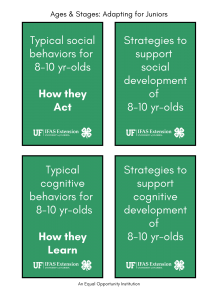
Examples of Ages & Stages Applied for Juniors
Throughout this series, we have been using examples from each of the three pillar programs in 4-H: Citizenship & Leadership, Science, and Healthy Living. These examples are meant to help parents and volunteers see how an activity can be adapted for each of the different age groups. For examples for other age groups, check out our previous post about Cloverbuds.
- Citizenship & Leadership: For citizenship & leadership, we have been using the example of a 4-H club business meeting. Eight to 10-year-olds can follow the club meeting script to begin to learn about the order of a business meeting. You can write a different role on popsicle sticks, then ask youth to draw a role at the beginning of each meeting. Y This way, they begin to learn about leadership roles and the business meeting model without the pressure of needing to know what to say. Eight to 10-year-olds will also want to be involved in committee work, led by an older, more experienced youth or with the help of a parent volunteer. During committee meetings, allow youth to plan parts of club events such as celebrations, fundraisers, or service projects.
- Science: For science, we have been using the 4-H entomology project as an example. Entomology is the study of insects. Eight to 10-year-olds can catch and begin to identify insects using a simple key. They may also want to pin and display their insects at their county or regional fair. They could also team up with a friend and give an illustrated talk or demonstration about what they have learned about insects for their club or county events.
- Healthy Living: For Healthy Living, we have been using the 4-H personal wellness project as an example. This project area helps youth learn about nutrition, physical fitness, and mental health. For juniors, this could be an opportunity for them to explore other cultures through food. Ask different youth to share what their family’s favorite meals are. This is a great way for them to cultivate learning beyond their home to include their neighborhood and community.
Using “Ages & Stages” approach with youth reinforces the Essential Elements of 4-H: Belonging, Mastery, Independence, and Generosity. This is also key to helping youth thrive. However, each individual youth grows at their own pace and might not completely meet the general tendencies listed above. As volunteers and 4-H professionals, it is important to observe youth and meet them where they are physically sociality, and intellectually. Adapting activities on the fly gets easier with practice- download this set of flashcards for a quick reference guide. You can print them, cut them out, and punch them to fit on a lanyard as a handy teaching aid. Your local 4-H agent is always available to help and provide additional resources if you have questions.
References:
Arnold, M. E. & Gagnon, R. J. (2020). Positive youth development theory in practice: An update on the 4-H Thriving Model. Journal of Youth Development, 15(6), 1-23.
Erikson, E. H. (1963). Childhood and Society (2nd Ed.). New York: Norton.
Kent, H.C. (2022). Informal learning to support volunteer performance. [Unpublished doctoral dissertation]. Florida State University.
Lee, F. and Go, C. (2002). Developmental stages. UC ANR 4-H Youth Development Program.
Piaget, J. (1971). The theory of stages in cognitive development. In D. R. Green, M. P. Ford, & G. B. Flamer, Measurement and Piaget. McGraw-Hill.
Pleskac, S. (2000). Educational design and delivery: Use of age-appropriate activities. VRKC fact sheet.
Vygotsky, L. S. (1978). Mind in society: The development of higher psychological processes. Cambridge, MA: Harvard University Press.
by pmdavis | Jul 1, 2022
It’s hard to believe the 4th of July is already upon us!
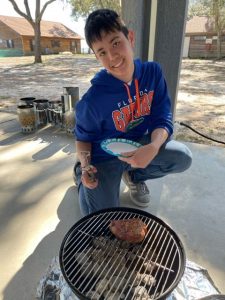
Youth learning to grill during 4-H tailgate program
Many of us will be celebrating with picnics, cookouts, and family get-togethers. One of my colleagues in Clay County, Samantha Murray, did a great article about preventing food poisoning while celebrating. Our youth have also been attending grilling summer camp programs and learning many of these tips plus lots more. The youth have learned about how to use a grill safely, how to prepare food safely and prevent cross-contamination or food-borne illness, and the nutritional benefits of animal protein in diets. Our district will have its annual competition to advance to the state-level competition on July 30 at the Washington County Extension Office, in Chipley, Florida.
I just wanted to take a moment to recap the tips Samantha gave to keep all of us safe and healthy while celebrating.
- Keep raw meats in a separate cooler than ready-to-eat items or beverages.
- Foods with mayonnaise are less acidic creating a better environment for bacterial growth
- Chicken and ground beef needs to be cooked to 165°F
- Wash hands if soap and water are not available use hand sanitizer to reduce the risk of contaminating food.
- Use different tongs or spatulas for cooked and uncooked meat or wash them after being in contact with raw meat.
- It is recommended to refrigerate leftovers within two hours unless it’s really hot, then the window shrinks to about an hour.
Other items you may want to think about.
- Keep beverages in a separate cooler from other foods, people will be going in and out of beverage coolers much more keeping the temperature higher and allowing bacterial growth.
- Cook cuts of pork, beef, or shrimp to 145°F
- Don’t sit charcoal grills on plastic tables and make sure the area is free from debris that can catch fire, including limbs or tents overhead.
- Clean up after yourself leaving only footprints in the area you were in!
- Enjoy time with friends and family safely!
For more information about educational programs, check out our webpage or contact your local UF IFAS Extension Office.
by Marie Arick | Jun 7, 2022
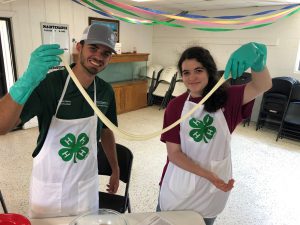
Mozzarella Cheese, 4-H U 2021
Youth participating in 4-H University can gain skills they can rely on for a lifetime! How do you ask? These youth (aged 14-18) get to explore numerous career opportunities by participating in educational workshops, lead community service projects, participate in competitive events, be recognized for their outstanding activities, and make friends with youth from across the state!
The weeklong 4-H University experience allows youth to self-select topics of interest and gain insightful experiences to explore these topics. This year’s tracks include livestock and dairy science to food science and culinary. Simply put, this is career exploration. These experiences are informative and introduce topics of interest that youth may want to consider as a career path. Many include the ‘learn by doing’ activities, for example making homemade mozzarella cheese, are designed to develop some life skills in the process. If that was not enough, there are competitive events such as illustrative talks and public speaking, a Share the Fun Contest that allows youth to share their talents with others, a campus tour for first -time attendees, and of course a youth banquet and a dance.
While speaking to a former 4-H State President, Mr. Matt Schmarje (99-00), he echoed the importance of 4-H University (at that time called Congress). By self-selecting workshops led to the introductions he had to numerous different topics and the building of life skills that he says have served him to this day. He then went on to express 4-H University also taught him team building skills, how to embrace people and their differences, and allowed him to develop and enhance his communication skills. The years he spent attending 4-H University allowed him to grow within the 4-H program through the many experiences that he has utilized in his life and career. Most importantly Matt emphasized how the accepting and embracing of other people and their differences opened his world to a variety of cultural experiences with people he is still friends with to this day.
If you would like more information on 4-H University, contact your local 4-H Agent or follow this link https://florida4h.ifas.ufl.edu/events/4-h-university/

by aschortinghouse | May 13, 2022
Horse Show
Youth from across north Florida gathered to compete at the 2022 Area
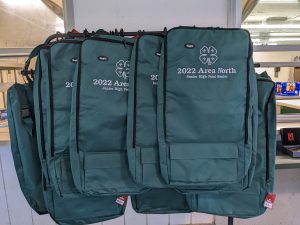
2022 Area North High Point Division Winners bridle bags.
North Horse Show in Clay County. Area shows take place throughout the state and serve as a qualifying show for the state show which takes place this summer. This is not just another horse show though, these 4-H Area shows are unique in that these shows are just one part of the larger project these youth are involved in. At the beginning of each year, youth declare which horses they will be working with. They are then responsible for working with their horses to learn more about equine sciences and to prepare for the various show and project opportunities such as workshops and shows. At the 2022 Area show, youth had the opportunity to participate in various disciplines including western, hunter, speed, and ranch divisions. Youth were eligible to earn ribbons, high points, and versatility awards. What youth are achieving inside the arena is second to that of what is being developed in our youth outside the arena.
Outside the Arena
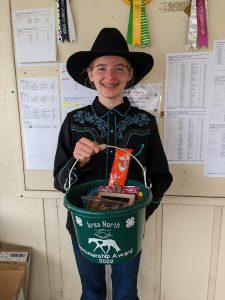
2022 Area North Horse Show Sportsmanship award winner.
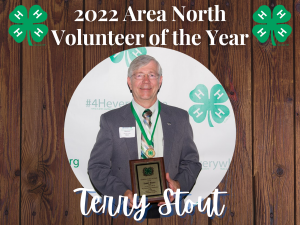
2022 Area North Volunteer of the Year.
In addition to the competition in the arena, youth and volunteers are recognized for their efforts outside the arena with various awards such as the sportsmanship and volunteer of the year awards. Horse projects and shows offer youth a chance to develop life skills, while loosing themselves in the magic of a horse. Horses demand responsibility, decision making, communication, among many other life skills. While some youth will be recognized for their success with ribbons, all of our youth are building skills that will carry them throughout their lifetimes. All of this though is not possible without the support and tireless effort put in by our volunteers. Thank you to all of our volunteers who made this even possible and congratulations to our 2022 volunteer of the year!
Congratulations to all the youth who competed and qualified for the State 4-H Horse Show later this year. To see a full list of qualifiers, click here. If you want to learn more about how you can get involved!
 In a recent study, one of the top things 4-H volunteers are looking for are ideas for adapting activities to different age groups (Kent, 2022). Florida 4-H offers experiences for four different age groups: Cloverbuds (ages 5-7), Juniors (ages 8-10), Intermediates (ages 11-13), and Seniors (ages 14-18). One of the great things about 4-H is that the whole family can participate! This also means that 4-H volunteers often find themselves working with a variety of age groups. That might seem a little overwhelming, but this post series gives practical tips and strategies to make it less daunting. This week’s post is focused on adapting activities for intermediate-age 4-H members. In case you missed it, check out the previous couple of weeks’ posts to learn about cloverbuds, juniors, and intermediates.
In a recent study, one of the top things 4-H volunteers are looking for are ideas for adapting activities to different age groups (Kent, 2022). Florida 4-H offers experiences for four different age groups: Cloverbuds (ages 5-7), Juniors (ages 8-10), Intermediates (ages 11-13), and Seniors (ages 14-18). One of the great things about 4-H is that the whole family can participate! This also means that 4-H volunteers often find themselves working with a variety of age groups. That might seem a little overwhelming, but this post series gives practical tips and strategies to make it less daunting. This week’s post is focused on adapting activities for intermediate-age 4-H members. In case you missed it, check out the previous couple of weeks’ posts to learn about cloverbuds, juniors, and intermediates. Using the “Ages & Stages” approach with youth reinforces the Essential Elements of 4-H: Belonging, Mastery, Independence, and Generosity. This is also key to helping youth thrive. However, each individual youth grows at their own pace and might not completely meet the general tendencies listed above. As volunteers and 4-H professionals, it is important to observe youth and meet them where they are physically sociality, and intellectually. Adapting activities on the fly gets easier with practice- download this set of flashcards for a quick reference guide. You can print them, cut them out, and punch them to fit on a lanyard as a handy teaching aid. Your local 4-H agent is always available to help and provide additional resources if you have questions.
Using the “Ages & Stages” approach with youth reinforces the Essential Elements of 4-H: Belonging, Mastery, Independence, and Generosity. This is also key to helping youth thrive. However, each individual youth grows at their own pace and might not completely meet the general tendencies listed above. As volunteers and 4-H professionals, it is important to observe youth and meet them where they are physically sociality, and intellectually. Adapting activities on the fly gets easier with practice- download this set of flashcards for a quick reference guide. You can print them, cut them out, and punch them to fit on a lanyard as a handy teaching aid. Your local 4-H agent is always available to help and provide additional resources if you have questions.









